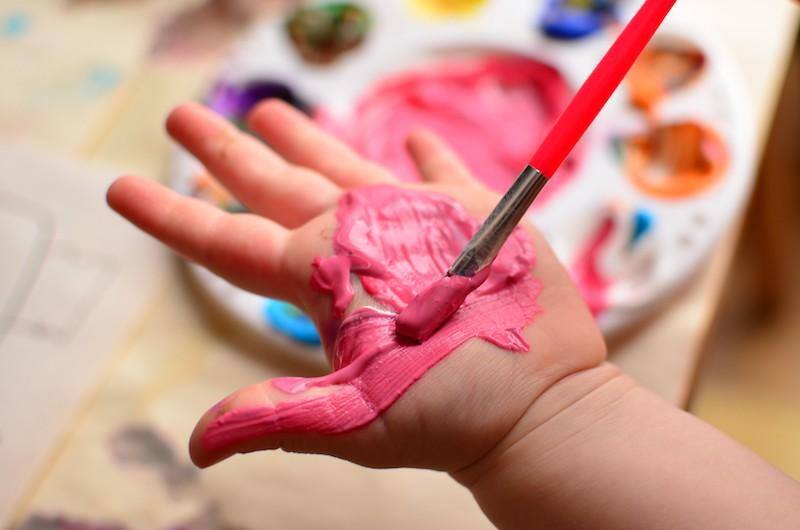Embrace the Mess: 5 Skills Developed Through Art Exploration
May 18th, 2020 | 3 min. read

Finger painting is too messy! I don't want to deal with little scraps of paper everywhere! Everything is sticky after an art project!
Do these concerns sound familiar? Sure, art can be messy. But, sometimes, that's the point! What really matters about art, aside from how satisfying it is, is that it is important in a child’s development. Art may seem like fun and games—and it is!—but through art explorations, children learn various importnat skills, from communication to fine motor. With all that learning taking place, so what if there's a little bit of clean-up involved?!
With schedules busier than ever, many parents and teachers can be reluctant to offer young children creative materials because they are concerned about the time these experiences take to prepare and the mess that will result. With these concerns in mind we asked early education art expert MaryAnn Kohl, "Why is it important to take the time to do art with such young children?"
Communication Skills: When a child draws a picture, paints a portrait, or hangs buttons from a wobbly mobile, that child is beginning to communicate visually. A child may draw to document an actual experience like playing in the park, release feelings of joy by painting swirling colors, or share an emotionally charged experience like the passing of a loved one through art. Art goes beyond verbal language to communicate feelings that might not otherwise be expressed.
Problem-Solving Skills: When children explore art ideas, they are testing possibilities and working through challenges, much like a scientist who experiments and finds solutions. Should I use a shorter piece of yarn to balance my mobile? This tape isn't holding -- what should I try instead? How did I make brown -- I thought I made orange? Art allows children to make their own assessments, while also teaching them that a problem may have more than one answer. Instead of following specific rules or directions, the child's brain becomes engaged in the discovery of "how" and "why." Even when experimenting or learning how to handle art materials effectively, children are solving challenges and coming up with new ways to handle unexpected outcomes.
Sociala and Emotional Skills: Art helps children come to terms with themselves and the control they have over their efforts. Through art, they also practice sharing and taking turns, as well as appreciating one another's efforts. Art fosters positive mental health by allowing a child to show uniqueness as well as success and accomplishment, which are all part of a positive self-concept.
Fine Motor Skills: Fine motor skills enable a child do things like delicately turn the page of a book or fill in a sheet of paper with written words. Holding a paintbrush so that it will make the desired marks, snipping paper with scissors into definite shapes, drawing with a crayon, or squeezing glue from a bottle in a controlled manner all help develop a child's fine motor skills and control of materials.
Self-Expression and Creativity: Children express themselves through art on a fundamental level. Sometimes their artwork is the manifestation of that expression, but more often, the physical process of creating is the expression. Picture a toddler who has a new baby sister and is busily pummeling his fists into playdough; a six-year-old joyfully painting flowers with huge arm movements blending, reds and yellows; a ten year-old drawing a portrait of her grandmother who recently passed away. Creating art allows children to work through feelings and emotions, and referring to a finished piece of artwork helps a child talk about feelings in a new and meaningful way. Art also develops a child's creativity. Rather than being told what to do, answers and directions come from the child. Art is an experience that requires freethinking, experimentation, and analysis -- all part of creativity. A final comment: I believe that art builds better humans to lead our civilization forward. Art contributes to encouraging children to grow to be society’s problem solvers, thinkers, inventors, and beyond – and not just society’s followers. Art is a place for children to learn to trust their ideas, themselves, and to explore what is possible.
About the Author
MaryAnn Kohl presents at workshops and keynotes around the country for teachers and librarians interested in teaching art with young children. She has appeared on various television shows, including Home Matters on the Discovery Channel, Take Part! (Canadian children’s television) as the ‘Mudworks lady’, and was a featured guest on 1, 2, 3 Grow! (Health Network). Kohl was also a consultant for a children’s activity television show produced by the Jim Henson Company (Odyssey Network). In addition, she consults for Fisher-Price, and works with SUNY-Albany as one of their expert guests for numerous educational video conferences. Kohl enjoys being a columnist for Family Fun magazine, and writes for numerous other magazines including, Parenting, Cricket, Scholastic, Early Childhood News, and Daycaring. Kohl also writes books for her own publishing company, Bright Ring Publishing. For more information on fostering creativity in young children, check out MaryAnn Kohl's latest book First Art for Toddlers and Twos and part 1 of our Q&A.
Author(s)MaryAnn F. Kohl
A graduate of Western Carolina University with a BA in English, Brianna served as a marketing and editorial Intern with Gryphn House in the Summer 2018.